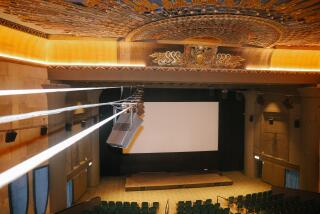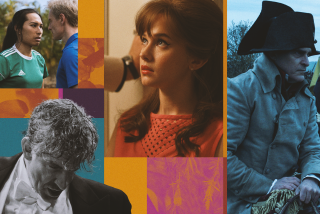When Fairbanks ruled
Eight decades ago, audiences around the world flocked to see the remarkable stunts, supreme athleticism, swarthy good looks and boundless charm of Douglas Fairbanks in a series of lavish swashbuckling adventures including “The Mark of Zorro,” “Robin Hood,” “The Three Musketeers” and “The Gaucho.”
Two of his best films, 1924’s “The Thief of Bagdad” and 1929’s “The Iron Mask,” are screening today and Monday, respectively, at the Academy of Motion Picture Arts and Science’s Samuel Goldwyn Theater.
“I think in all of our obsession with comic-book movies we have going on, we forget that he’s the guy who basically gave us action-adventure as a genre and did it with still undeniable style and panache,” says academy programmer Randy Haberkamp. “He’s a rare blend of Harrison Ford and Nijinsky. It’s amazing.”
The films are being presented in conjunction with the exhibition “Douglas Fairbanks: The First King of Hollywood” at the academy’s fourth-floor gallery, as well as with the academy’s publication of “Douglas Fairbanks” by Jeffrey Vance with Tony Maietta and photographic editor Robert Cushman. The trio will be signing copies after the screening of “Thief” this evening.
Introducing the films will be the pre-eminent silent film historian Kevin Brownlow (“The Parade’s Gone By”), who is flying in from England for the events. Both of the restorations were supervised by Brownlow and feature new orchestral scores by Carl Davis.
It was Fairbanks who spurred Brownlow’s interest in silent films. “As a kid starting out as a film collector, it was a Fairbanks film I first acquired, ‘American Aristocracy’ from 1916. It had a fascinating series of effects.”
Fairbanks appealed to audiences, says Brownlow, because “he’s so self-deprecating and still so amazingly skillful as an athlete. He knows he can’t act, is extremely endearing, and he makes sure that you know that he knows.”
Directed by Raoul Walsh and featuring the ornate, imaginative sets of William Cameron Menzies, “The Thief of Bagdad” is literally a magic carpet ride of effects and stunts. “It’s so imaginative and extraordinary,” says Brownlow.
What’s most astonishing about the film are the physical risks Fairbanks took, especially on the magic carpet, which was suspended in the air simply by six lengths of piano wire.
“I wouldn’t have done it for anything,” says Brownlow.
He reinstated the color tinting, which includes amber and blue tones, to the film. “Fortunately, somebody had kept a record over here so we could bring back the tinting.”
“The Iron Mask” was Fairbanks’ final silent film, which was released nearly two years after the introduction of talkies. It’s a beautifully designed swashbuckler based on the Dumas novels in which he plays the aging musketeer D’Artagnan.
The 1929 version of the film had disappeared completely from view because his son, Douglas Fairbanks Jr., had produced a new version with the old footage in 1953.
“He shortened the film and had spoken the narration that went with it,” says Brownlow. “It was so effective I wondered whether the silent one would be any good at all. But the silent film is a film of much greater stature.”
--
--
‘Douglas Fairbanks’
Where: Samuel Goldwyn Theater, 8949 Wilshire Blvd., Beverly Hills
When: “The Thief of Bagdad,” today at 7:30 p.m.; “The Iron Mask,” Monday at 7:30 p.m.
Price: $5
Contact: www.oscars.org or (310) 247-3600
More to Read
The biggest entertainment stories
Get our big stories about Hollywood, film, television, music, arts, culture and more right in your inbox as soon as they publish.
You may occasionally receive promotional content from the Los Angeles Times.











